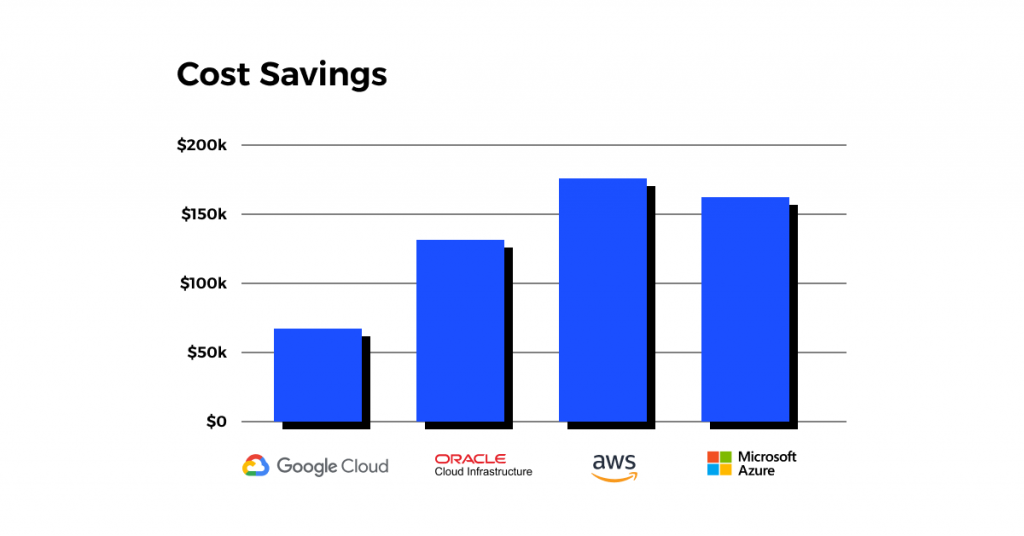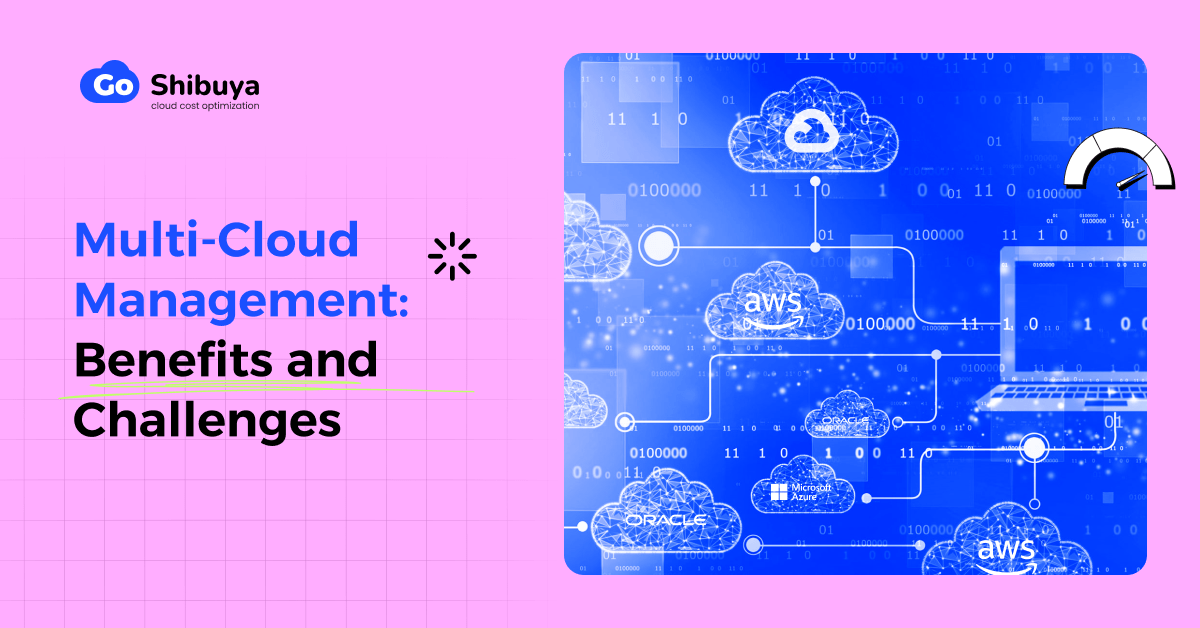Over the recent couple of years, more businesses and organizations have switched from relying on a single cloud provider and started adopting multi-cloud environments. In fact, according to Virtana’s report, The State of Multi-Cloud Management, 82% of organizations are already leveraging a multi-cloud strategy, and 78% are currently running their workloads in more than three public clouds.
Using multiple cloud providers to manage your cloud resources does come with a bunch of benefits. Minimized dependence on a single cloud provider, greater flexibility, and improved cost-efficiency are just a few to mention. Yet managing multi-cloud environments effectively also presents certain challenges to organizations.
Uncover opportunities to optimize your cloud, simplify cloud management, and reduce costs.
In this blog, we’ll take a closer look at the key benefits and challenges businesses may face when it comes to managing multi-cloud infrastructure and how multi-cloud management tools can help them do it much more effectively and effortlessly.
Multi-Cloud Management: What is Multi-Cloud?
Multi-cloud basically means the usage of cloud computing services from two or more public cloud vendors for different purposes within a single organization. For example, a business might use AWS (Amazon Web Services) for its data storage needs, GCP (Google Cloud Platform) for development and testing, and Microsoft Azure to secure disaster recovery. By doing so, businesses can enjoy the benefits offered by different public cloud providers while also avoiding the disadvantages of each.
In an ideal scenario, a business would use a multi-cloud management platform (there are plenty of such tools available out there) that supports all major public cloud vendors (AWS, GCP, Azure, and OCI) and manage multiple clouds from a single interface.
As this approach is becoming increasingly popular in today’s business environment, it naturally accounts for the rapid growth of various tools and technologies that are specifically designed to help businesses optimize and better manage their multi-cloud environments without having to constantly switch between multiple interfaces. Without such tools, the entire multi-cloud management process might become a lot more challenging and complicated for your IT team.
Not surprisingly, the global multi-cloud management market size is expected to grow from US$ 10.28 billion in 2023 to US$ 121.35 billion by 2033, according to a report by Future Market Insights. The increasing adoption of multi-cloud strategies is a primary reason for the market expansion. In addition, the need for centralized management, the rise of hybrid cloud environments, and the growing adoption of containerization and microservices for cloud-native applications are also among the key driving factors behind the multi-cloud management market growth.
Manage your single or multi-cloud infrastructure and cut down on your cloud bill.

Multi-Cloud vs. Hybrid Cloud: What is the Difference?
Before we proceed to the benefits, let’s make it clear how multi-cloud differs from hybrid cloud. While the two terms are often used interchangeably, these are not the same. A multi-cloud approach involves using multiple public cloud service providers, which allows businesses to leverage the specific features and strengths of each provider.
In contrast, a hybrid cloud approach describes an architecture with public and private cloud (on-premises) solutions combined. Organizations primarily use hybrid cloud deployments when they want to maximize the benefits of public clouds while ensuring some workloads or applications remain on-premises so they can maintain complete control over critical data.
Benefits of Adopting a Multi-Cloud Approach
Based on the HashiCorp 2022 State of Cloud Strategy Survey, 90% of those who have adopted a multi-cloud approach say it is already helping their organization achieve their business goals. Let’s now go through the specific benefits your business can achieve from implementing a multi-cloud management approach. If you are not sure yet whether a multi-cloud strategy is what you should be opting for, having a deeper understanding of the advantages that you can get might actually change your mind.
Avoiding vendor lock-in
Reducing dependability on a single cloud provider is, for sure, one of the key benefits of implementing a multi-cloud deployment. Instead of being forced to work with a single cloud vendor, you can operate across multiple providers, which means you have many more options to choose from to match your specific business needs and achieve the best outcomes for different IT requirements while also saving costs.
Increased availability and reliability
A multi-cloud approach provides greater flexibility and reliability, which might be critical to ensuring your business continuity. Think of a scenario when a disaster or outage occurs. If you are tied to a single vendor, that might cause disruptions in your business operations. Multi-cloud reduces the risk of a single point of failure because in the case of an outage in one cloud, you can simply move your computing needs to another cloud.
Leveraging innovative technologies
There is a fierce competition in the public cloud market as everyone is trying to win a larger market share. That obviously drives major providers to innovate and constantly invest in developing new products and solutions. For businesses, it means that by adopting a multi-cloud strategy, you can leverage the latest technologies and innovative solutions from multiple vendors without being limited to the choices offered by a single provider.
Greater cost efficiency

Finally, many businesses and organizations opt for a multi-cloud strategy to take advantage of the available discounts and cost-saving opportunities offered by different public cloud providers, making it an excellent option for reducing their overall cloud spend. By working with multiple cloud vendors, you can get the best combination of pricing and performance. Plus, with a multi-cloud management platform, your cost savings can be even greater.
Challenges of Multi-Cloud Management
Despite the immense benefits, multi-cloud management does come with a number of challenges and difficulties. Firstly, every cloud provider has its own features, services, operating model, taxonomy, SLAs, APIs, and management tools. Thus, the biggest challenge lies in properly identifying, selecting, and deploying the right services for specific purposes in every cloud environment, as well as synchronizing workloads across multiple clouds. Let’s discuss the major challenges and roadblocks to multi-cloud management in more detail.
Increased management complexity
While sticking to one specific cloud provider means that your IT staff becomes very fluent in managing workloads in a single cloud environment, multi-cloud environments are naturally more complex to manage. Having to toggle between multiple providers and managing them all effectively puts additional strain on your IT team. In addition, you need to take into consideration potential risks associated with data security and privacy, which adds to the management complexity.
Integrating software environments
To fully harness the power of multi-cloud, you need to build applications that can seamlessly move across different cloud environments without creating integration problems. And it comes with certain difficulties, given the differences between various cloud vendors. An additional challenge comes with managing software licenses across providers when moving applications in the cloud.
Managing multiple cloud bills
Though operating across multiple public clouds results in increased cost efficiency as you can take advantage of the best offerings from each provider, as we’ve mentioned above, managing cloud costs associated with different vendors can become an incredibly complex task. Every provider has its own pricing structure, bill formats, and billing cycles – learning how to best manage costs across several providers might need some time and effort on your part.
Steep learning curve
Each new cloud provider you choose to add to your multi-cloud environment has a unique set of technical characteristics and aspects that might be new for your current team. And here comes the difficulty of having to educate and train your IT staff on specific skills and knowledge on how to best manage a new cloud platform in the most efficient way. Instead, you might need to hire new staff with multi-cloud skills, which can be challenging, too, not to mention the time it might take.
Finding the right multi-cloud-management tool
Luckily, all these challenges of multi-cloud management can be addressed with a proper multi-cloud management platform. However, not all multi-cloud management solutions are equally efficient in managing multi-cloud complexity and providing enough visibility into your cloud resources and costs across multiple cloud providers. Finding the tool with the right set of features and capabilities and an intuitive interface where you can visualize and monitor everything in one place can also be a daunting task.
Managing Your Multi-Cloud Environment with Shibuya
Multi-cloud management strategies and solutions are serving the purpose of streamlining and optimizing the management of multiple public cloud providers by centralizing the entire process. By providing your IT team with a single multi-cloud management solution like Shibuya multi-cloud cost intelligence platform and enabling them to manage and control workloads across multiple clouds in one centralized location, you can automate and optimize the entire multi-cloud management process.
While there are many cloud management tools that allow you to manage a single cloud, with cross-cloud management platforms, you can reduce the number of tools you need to manage your multi-cloud deployment. Thus, to sum it up, when you use a professional multi-cloud management platform, you can enjoy:
- Complete visibility across your multi-cloud environment;
- Reduced complexity of managing multiple public clouds;
- More efficient cost management and cloud cost reduction.
With Shibuya, you can get a holistic view of your multi-cloud environment across AWS, GCP, OCI, Azure, and even Kubernetes in one interface instead of using multiple platforms. Most importantly, it allows you to track and report on costs by projects, products, servers, and providers and enables you to instantly resize and set schedules for your resources based on usage patterns so you can eliminate wasteful cloud spending.
Schedule a demo call today to see Shibuya multi-cloud cost management platform in action and learn how it can simplify and optimize your multi-cloud management, empowering your FinOps with complete visibility into your entire multi-cloud environment and enabling them to unlock significant cloud cost-savings.
